In Semantic Web languages, such as RDF and OWL, a property is a
binary relation: it is used to link two individuals or an individual
and a value. How do we represent relations among more than two individuals?
How do we represent properties of a relation, such as our certainty about it,
severity or strength of a relation, relevance of a relation, and so on? The
document presents ontology patterns for representing n-ary relations and
discusses what users must consider when choosing these patterns.
Status of this Document
This section describes the status of this document at the time of its
publication. Other documents may supersede this document. A list of current
W3C publications and the latest revision of this technical report can be
found in the W3C technical reports index
at http://www.w3.org/TR/.
This document will be a part of a larger document that will provide an
introduction and overview of all ontology design patterns produced by the Semantic Web Best Practices
and Deployment Working Group.
This document is a W3C Working Draft and is expected to change. The SWBPD
WG does not expect this document to become a Recommendation. Rather, after
further development, review and refinement, it will be published and
maintained as a WG Note.
This document is a Public Working Draft. We encourage public comments.
Please send comments to public-swbp-wg@w3.org
Open issues, todo items:
- Different namespaces for A-Box and T-Box1
Publication as a draft does not imply endorsement by the W3C Membership.
This document is a draft and may be updated, replaced or made obsolete by
other documents at any time. It is inappropriate to cite this document as
other than work in progress.
General issues
In Semantic Web languages, such as RDF and OWL, a property is a
binary relation: instances of properties link two individuals. Often
we refer to the second individual as the "value" or to both both individuals
as "arguments" [See note on vocabulary].
Issue 1: If property instances can link only two individuals, how do we deal
with cases where we need to describe the instances of relations, such
as its certainty, strength, etc?
Issue 2: If instances of properties can link only two individuals, how do we
represent relations among more than two individuals? ("n-ary relations")
Issue 3: If properties can link only two individuals, how do we represent relations
in which one of the participants is an ordered list of individuals rather than
a single individual?
The solutions to the first two problems are closely linked; the third
problem is fundamentally different, although it can be adapted to meet issue
one in special cases.
Use case examples
Several common use cases fall under the category of n-ary relations. Here
are some examples:
- Christine has breast tumor with high probability. There is a
binary relation between the person
Christine and diagnosis
breast_tumor and there is a qualitative probability value
describing this relation (high).
- Steve has temperature, which is high, but falling. The
individual
Steve has two values for two different aspects of
a has_temperature relation: its magnitude is
high and its trend is falling.
- John buys a "Lenny the Lion" book from books.example.com for $15 as
a birthday gift. There is a relation, in which individual
John, entity books.example.com and the book
Lenny_the_Lion participate. This relation has other
components as well such as the purpose (birthday_gift) and
the amount ($15).
- United Airlines flight 3177 visits the following airports: LAX,
DFW, and JFK. There is a relation between the individual flight and
the three cities that it visits,
LAX, DFW,
JFK. Note that the order of the airports is important and
indicates the order in which the flight visits these airports.
Another way to think about the use cases is how they might occur in the
evolution of an ontology.
- We discover that a relation that we thought was binary, really needs a
further argument - a common origin of use case 1.
- We discover that two binary properties always go together and should be
represented as one n-ary relation - a common origin for use case 2
- From the beginning, we realise that the relation is really amongst
several things - a common origin for use case 3
- The nature of the relation is such that one or more of the arguments is
fundamentally a sequence rather than a single individual - use case
4.
Representation patterns
As we describer earlier, in Semantic Web Languages, properties are binary
relations. Each instance of a property links two individuals as shown
below.

We would like to have another individual or simple value C to
be part of this relation instance:
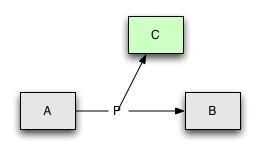
'P' now refers to an instance of a relation among 'A',
'B', and 'C'. (There might be other individuals 'D',
'E', and 'F', but we will assume a single additional individual for simplicity.)
One common solution to this problem is to re-represent the relation as a class
rather than a property. Individual instances of such classes correspond to instances
of the relation. Addtional properties provide binary links to each argument
of the relation. Ontologically such classes are often called "reified relations".
Reified relations play important roles in many ontologies2 (e.g. Ontoclean/DOLCE, Sowa, GALEN). However, note that the RDF and
Topic Map communities have each used the word "reify" to mean other things (see
the note below). Therefore, to avoid confusion
in this document, we usually speak of "re-representation" rather than "reification".
A second solution is to represent several individuals participating in the
relation as a collection or an ordered list.
Depending on the relation among A, B, and C,
and how the situation arose, we distinguish three patterns to represent
n-ary relations in RDF and OWL: The first two patterns (pattern
1 and pattern 2) introduce a new class for an n-ary
relation. These two patterns converge have the same representation from the
logical point of view, although they are likely to arise in different ways and
represent different modeling patterns. In these patterns the labelling
of the arguments to the n-ary relation is important, but their order
is not. The third pattern(pattern 3) uses a list to
encapsulate several arguments. This pattern is used when one (or more) of the
arguments is an ordered list and the ordering is fundamentally important in
the model.
Introducing a new class for a relation
We present two patterns where we create a new class and n new properties
to represent an n-ary relation. An instance of the relation linking
the n individuals is then an instance of this class. Note that while
these two patterns are equivalent logically, they provide two different viewpoints
and users may find one or the other more convenient in a given situation (see
Considerations when introducing a new class for a
relation).
In the first case (pattern 1), one of the individuals
in the relation (say, A) is distinguished from others in that it
is the subject of the relation. Just like in the case of a binary relation,
where P was a property of A with value B,
here the instance of the relation itself is a property value of A.
This value is a complex object in itself, relating several values and individuals.
Examples 1 and 2 from the list above fall under this category: Christine
and Steve in these examples are individuals that the properties
are describing. These examples commonly arise in the course of the evolution
of an ontology when we discover that a simple binary relation is insufficient
to represent the complexity required.
In the second case (pattern 2), the n-ary relation
represents a network of participants that all play different roles in the
relation, but two or more of the participants have equal "importance" in the
relation. Example 3 above would usually fall into this category: At least
John, books.example.com, and the
Lenny_The_Lion book seem to be equally important in this
purchasing relation.
Pattern 1:
If we need to represent an additional attribute describing a relation
instance (example 1, Christine has breast tumor with high
probability) or represent a relation instance that has different
components (example 2, Steve has temperature, which is high, but
falling), we can create an individual that includes the relation
instance itself, as well as the additional information about this
instance:
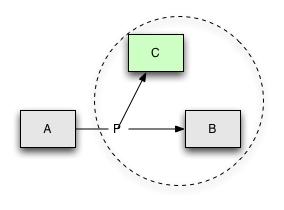
For the example 1 above (Christine has breast tumor with high probability),
the individual Christine has a property has_diagnosis
that has another object (_:Diagnosis_Relation_1, an
instance of the class Diagnosis_Relation) as its value:
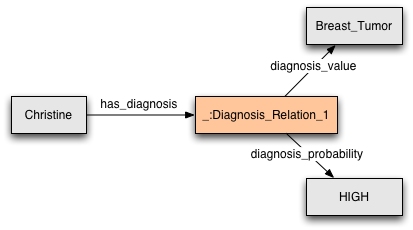
The individual _:Diagnosis_Relation_1 here represents
a single object encapsulating both the diagnosis (breast_tumor)
and the probability of the diagnosis (HIGH)2. It contains all the information held
in the original 3 arguments: who is being diagnosed, what the diagnosis is,
and what the probability is. We use blank
nodes in RDF to represent instances of a relation.
:Christine
a :Person ;
:has_diagnosis _:Diagnosis_Relation_1 .
:_Diagnosis_relation_1
a :Diagnosis_Relation ;
:diagnosis_probability :HIGH;
:diagnosis_value :Breast_Tumor .
Each of the 3 arguments in the original n-ary relation—who is being
diagnosed, what the diagnosis is, and what the probability is—gives
rise to a true binary relationship. In this case, there are three:
has_diagnosis, diagnosis_value and
diagnosis_probability.3
The class definitions for the individuals in this pattern look as follows:

The additional labels on the links indicate the OWL restrictions on the properties.
We define both diagnosis_value and diagnosis_probability
as functional properties, thus requiring that each instance of Diagnosis_Relation
has exactly one value for Disease and one value for Probability.
In RDFS, which does not have the OWL restrictions or functional properties,
the links represent rdfs:range constraints on the properties. For
example, the class Diagnosis_Relation is the range of the property
has_diagnosis.
Here is a definition of the class Diagnosis_Relation in OWL, assuming that both
properties—diagnosis_value and
diagnosis_probability—are defined as functional (we
provide full code for the example in OWL and RDFS below):
:Diagnosis_Relation
a owl:Class ;
rdfs:subClassOf
[ a owl:Restriction ;
owl:someValuesFrom :Disease ;
owl:onProperty :diagnosis_value
] ;
rdfs:subClassOf
[ a owl:Restriction ;
owl:allValuesFrom :Probability_values ;
owl:onProperty :diagnosis_probability
] .
In the definition of the Person class (of which the individual
Christine is an instance), we specify a property has_diagnosis
with the range restriction going to the Diagnosis_Relation class
(of which Diagnosis_1 is an instance):
:Person
a owl:Class ;
rdfs:subClassOf
[ a owl:Restriction ;
owl:allValuesFrom :Diagnosis_Relation ;
owl:onProperty :has_diagnosis
] .
RDFS code for this example
[RDFS]
OWL code for this example
[N3] [RDF/XML]
We have a different use case in the example 2 above (Steve has temperature,
which is high, but falling): In the example with the diagnosis, many will
view the relationship we were representing as in a fact still a binary
relation between the individual Christine and the diagnosis breast_tumor
that has a probability associated with it. The relation in this example is between
the individual Steve and the object representing different aspects
of the temperature he has. In most intended interpretations, this instance of
a relation cannot be viewed as an instance of a binary relation with additional
attributes attached to it. Rather, it is a relation instance relating the individual
Steve and the complex object representing different facts about
his temperature. Such cases often come about in the course of evolution of an
ontology when we realize that two relations need to be collapsed. For example,
initially, we might have had two properties—has_termperature_level
and has_temperature_trend—both relating to people. We might
then have realized that these properties really are inextricably intertwined
because we need to talk about "termperatures that are elevated but falling."

The RDFS and OWL patterns that implement this intuition are however the same
as in the previous example. A class Person (of which the individual
Steve is an instance) has a property has_temperature
which has as a range the relation class Temperature_Relation. Instances
of the class Temperature_Relation (such as _:Termperature_Relation_1
in the figure) in turn have properties for temperature_value and
temperature_trend.
RDFS code for this example
[RDFS]
OWL code for this example
[N3] [RDF/XML]
Pattern 2:
In some cases, the n-ary relationship represents a network of individuals
that play different roles in a structure without any single individual
standing out as the subject or the "owner" of the relation, such as
Purchase in the example 3 above (John buys a "Lenny the
Lion" book from books.example.com for $15 as a birthday gift). Here, the
relation explicitly has more than one participant, and, in many contexts,
none of them can be considered a primary one. In this case, we create an
individual to represent the relation instance with links to all
participants:
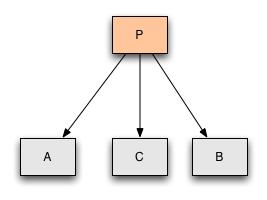
In our specific example, the representation will look as follows:
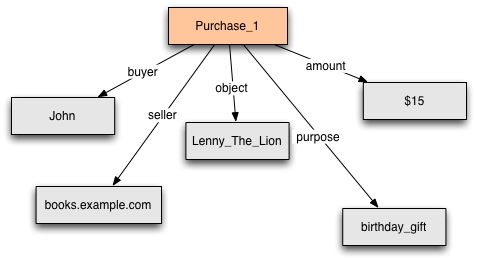
Purchase_15 is an individual instance of the Purchase
class representing an instance of a relation:6
:Purchase_1
a :Purchase ;
:buyer :John ;
:object :Lenny_The_Lion ;
:purpose :Birthday_Gift ;
:seller :books.example.com .
The following diagram shows the corresponding classes and properties. For
the sake of the example, we specify that each purchase has exactly one
buyer (a Person), exactly one seller
(a Company), exactly one amount and at least one
object (an Object).
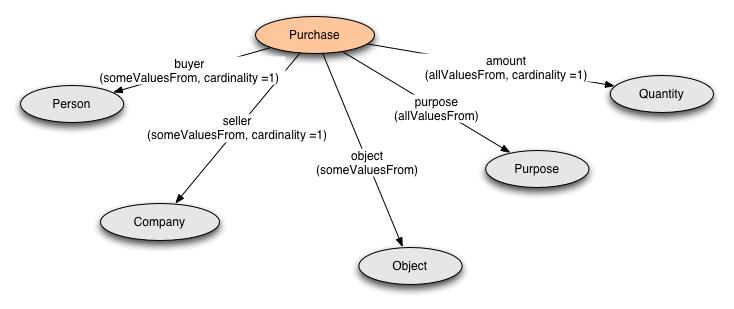
The diagram refers to OWL restrictions. In RDFS the arrows can be treated
as rdfs:range links.
The class Purchase is defined as follows in OWL (see the RDFS
file below for the definition in RDFS):
:Purchase
a owl:Class ;
rdfs:subClassOf
[ a owl:Restriction ;
owl:allValuesFrom :Purpose ;
owl:onProperty :purpose
] ;
rdfs:subClassOf
[ a owl:Restriction ;
owl:cardinality 1 ;
owl:onProperty :buyer
] ;
rdfs:subClassOf
[ a owl:Restriction ;
owl:onProperty :buyer ;
owl:someValuesFrom :Person
] ;
rdfs:subClassOf
[ a owl:Restriction ;
owl:cardinality 1 ;
owl:onProperty :seller
] ;
rdfs:subClassOf
[ a owl:Restriction ;
owl:onProperty :seller ;
owl:someValuesFrom :Company
] ;
rdfs:subClassOf
[ a owl:Restriction ;
owl:onProperty :object ;
owl:someValuesFrom :Object
] .
RDFS code for this example
[RDFS]
OWL code for this example
[N3] [RDF/XML]
Considerations when introducing a new
class for a relation
- The two patterns for introducing a new class for a relation are logically
equivalent. However, one or the other may seem more natural in specific
situations. In many cases, the choice between the two patterns above
is subjective.
In the first pattern, we have essentially a binary relation with an additional
property on it. We re-represent this relation as a class. In the second pattern,
we have a relation that indeed has several participants. In this case, we
represent it as a network of binary relations.
A more principled approach to the distinction is that the difference is
"ontological" rather than logical. In the first pattern, there is a relation
between two independent entities or between one independent and two or more
dependent entities. Christine and her breast tumour are independent things
that make sense on their own. The probability is dependent; probabilities
make no sense without something to be a probability of. In the second example,
there is a relation between a single independent entity and a "quality"
with two different aspects. In pattern 2, by contrast, there are at least
three independent entities - John, boxes.example.com,
and Lenny_the_Lion. (We won't discuss the status of birthday_gift
here.)
- One practical consequence of this difference is that we are unlikely
to be interested in the inverses to the links to the dependent entities
in pattern 1, whereas we are to the independent entities in pattern 2.
- A second practical consequence is that we will likely represent the
dependent entities—
Probability, Elevated
and Falling—as one of a set of specified values (See
note on Representing
Specified Values in OWL.)
- In our example, we did not give meaningful names to instances of
properties or to the classes used to represent instances of n-ary relations,
but merely label them
_:Temperature_Relation_1, Purchase_1,
etc. In most cases, these individuals do not stand on their own but merely
function as auxiliaries to group together other objects. Hence a distinguishing
name serves no purpose. Note that a similar approach is taken when reifying
statements in RDF.
- OWL allows definition of inverse properties.
Defining inverse properties with n-ary relations, using any of the patterns
above, requires more work than with binary relations. Each of the properties
participating in the n-ary relation should have its own inverse property (with
the proper constraints). Consider the example of
John buying
the Lenny_The_Lion book. We may want to have an instance of an
inverse relation pointing from the Lenny_The_Lion book to the
person who bought it. If we had a simple binary relation John
buys Lenny_The_Lion, defining an inverse is simple:
we simply define a property is_bought_by as an inverse of buys:
:is_bought_by
a owl:ObjectProperty ;
owl:inverseOf :buys .
With the purchase relation represented as an instance, however, we need to
add inverse relations between participants in the relation and the instance
relation itself:
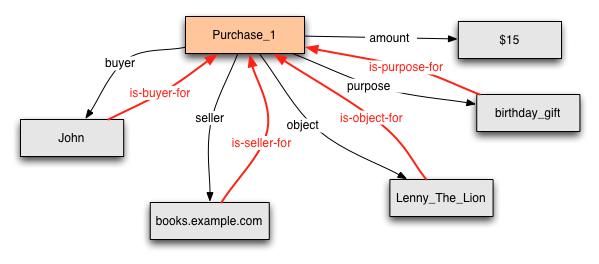
For example, the definitions of the inverse relations for for agent
and object of a purchase, look as follows:
:is_buyer_for
a owl:ObjectProperty ;
owl:inverseOf :buyer .
:is_object_for
a owl:ObjectProperty ;
owl:inverseOf :has_object .
And the definition of the Person class (taking into account the
inverse for the recipient property) is:
:Person
a owl:Class ;
rdfs:subClassOf
[ a owl:Restriction ;
owl:onProperty :is_buyer_for ;
owl:allValuesFrom :Purchase
] .
Note that the value of the inverse property is_buyer_for for
the individual John, for example, is the individual Purchase_1
rather than the object or recipient of the purchase.
Using lists for arguments in a relation
Some n-ary relations do not naturally fall into either of the two patterns
above, but are more similar to a list or sequence of arguments. The example 4
above (United Airlines flight 3177 visits the following airports: LAX,
DFW, and JFK) falls into this category. In this example, the relation
holds between the flight and the airports it visits, in the order of the
arrival of the aircraft at each airport in turn. This relation might hold
between many different numbers of arguments, and there is no natural way to
break it up into a set of distinct properties relating the flight to each
airport. At the same time, the order of the arguments is highly
meaningful.
Pattern 3:
In cases where all but one participants in a relation do not have a
specific role and essentially form a list, it is natural to connect the
airport arguments into a sequence and to relate the flight to this sequence.
We represent the sequence as a list, where each list item points to its
content and to the rest of the list:
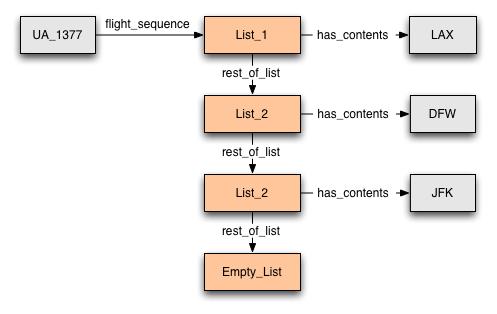
RDF in fact supplies a vocabulary for just this purpose—the collection
vocabulary. Thus, implementation of this pattern in RDF is
straightforward: We simply use rdf:List for this purpose.
Individuals List_1, List_2, List_3 and
Empty_List are instances of rdf:List; the property
has_contents is, in fact, the property rdf:first
and the property rest_of_list is simply rdf:rest.
We provide the full RDFS code for this example.
We can use the same rdf:List construct in OWL. However, using
rdf:List this way in OWL puts the ontology in OWL Full. If we want to keep
the ontology in OWL-DL, we can explicitly define the properties in the figure
above in our OWL ontology:
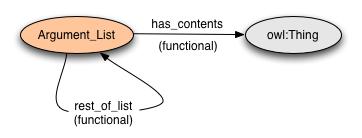
RDFS code for this example
[RDFS]
OWL code for this example
[N3] [RDF/XML]
Considerations when using a list of arguments in a relation
- This technique requires only two
properties—
rdf:first and rdf:rest or
has_contents and rest_of_list—(and the
empty-list individual) for any number of arguments and any number of
instances, and it permits some elegant techniques for manipulating the
sequences. These patterns are commonly used in programming, and have been
called S-expressions, or linked list structures.
- The down-side of this approach, obvious from the figure, is that this
technique uses a lot more triples and extra 'blank' nodes to encode a
single instance of an n-ary relation.
- If you do not need to stay in OWL DL, you do not need to create the new
class and properties for handling lists and can simply use
rdf:List directly.
N-ary relations and reification in RDF
It may be natural to think of RDF
reification when representing n-ary relations. Using the RDF reification
vocabulary to represent n-ary relations in general is a bad idea. The RDF
reification vocabulary is designed to talk about
statements—individuals that are instances of
rdf:Statement. A statement is a object, predicate, subject
triple and reification in RDF is used to put additional information about
this triple. This information may include the source of the information in
the triple, for example. In n-ary relations, however, additional arguments in
the relation do not usually characterize the statement but rather provide
additional information about the relation instance itself. Thus, it is more
natural to talk about instances of a diagnosis relation or a purchase rather
than about a statement.
We usually think of semantic web languages as consisting of triples of the
form "Individual1-Property-Individual2" (Traditionally, these have been
termed "object-attribute-value" triples, but we do not use this language here
because it conflicts with RDF usage.)
However, formally, we interpret properties as representing relations, i.e.
sets of ordered pairs of individuals. Each instance of a relation is just one
of those ordered pairs. The "Property" in each triple is fundamentally
different from the individuals in the triple. It merely indicates to which
relation the ordered pair consisting of the two individuals belongs. We
normally name individuals; we do not normally name the ordered pairs.
Anonymous vs named instances in these patterns
Often in cases such as pattern 1, we wish to regard
two instances of the relation that have the sane argument as equivalent. We
can capture this intuition by using RDF blank
nodes (e.g., _:Diagnosis_relation) to represent relation instances.In
pattern 2, we wish to consider the possibility that
there might be two distinct purchases with identical arguments. In that case,
the node should be named, e.g. Purchase_1.
Notes
- http://lists.w3.org/Archives/Public/public-swbp-wg/2004Jul/0009.html
- "Reified relations" play and important role
or have a special status in a number of ontologies, e.g. see Sowa, J. Knowledge
Representation. Morgan Kaufmann, 1999; Welty, C. and Guarino, N. Supporting
ontological analysis of taxonomic relationships. Data and Knowledge Engineering,
39 (1). 51-74.
- For simplicity, we represent each disease
as an individual. This decision may not always be appropriate, and we refer
the reader to a different note (ref to be added). Similarly, for
simplicity, in OWL we represent probability values as a class that is an enumeration
of three individuals (
HIGH, MEDIUM, and LOW):
:Probability_values
a owl:Class ;
owl:equivalentClass
[ a owl:Class ;
owl:oneOf (:HIGH :MEDIUM :LOW)
] .
There are other ways to represent partitions of values. Please refer to
a note on Representing Specified Values in OWL [Specified Values ]. In RDF Schema version,
we represent them simply as strings, also for simplicity reasons.
- RDF has a property
rdf:value
that is appropriate in examples such as the Diagnosis example here. While
rdf:value has no meaning on its own, RDF specification encourages
its use as a vocabulary element to identify the "main" component of a structured
value of a property. Therefore, in our example, we made diagnosis_value
a subproperty of rdf:value property instead of diagnosis_value
property to indicate that diagnosis_value is indeed the "main"
component of a diagnosis.
- Note that we used a named individual for an instance
of the class
Purchase (Purchase_1) rather than an
anonymous blank node here. In this example, there might be two distinct purchases
with exactly the same arguments.
- For simplicity, we will ignore the fact that the
amount is expressed in $ and will use a simply number as the value for the
property. For a discussion on how to represent units and quantities in OWL,
please refer to a different note (ref to be added)
- [Specified
Values]
- Representing
Specified Values in OWL: "value partitions" and "value
sets", Alan Rector, Editor, W3C Working Draft, 3 August
2004, http://www.w3.org/TR/swbp-specified-values/ .
- [OWL Overview]
- OWL Web
Ontology Language Overview, Deborah L. McGuinness and Frank
van Harmelen, Editors, W3C Recommendation, 10 February 2004,
http://www.w3.org/TR/2004/REC-owl-features-20040210/ . Latest version available
at http://www.w3.org/TR/owl-features/ .
- [OWL Guide]
- OWL
Web Ontology Language Guide, Michael K. Smith, Chris Welty,
and Deborah L. McGuinness, Editors, W3C Recommendation, 10 February
2004, http://www.w3.org/TR/2004/REC-owl-guide-20040210/ . Latest version available at
http://www.w3.org/TR/owl-guide/ .
- [OWL
Semantics and Abstract Syntax]
- OWL Web
Ontology Language Semantics and Abstract Syntax, Peter F.
Patel-Schneider, Patrick Hayes, and Ian Horrocks, Editors, W3C
Recommendation, 10 February 2004,
http://www.w3.org/TR/2004/REC-owl-semantics-20040210/ . Latest version available
at http://www.w3.org/TR/owl-semantics/ .
- [RDF Primer]
- RDF
Primer, Frank Manola and Eric Miller, Editors, W3C
Recommendation, 10 February 2004,
http://www.w3.org/TR/2004/REC-rdf-primer-20040210/ . Latest version available at
http://www.w3.org/TR/rdf-primer/ .
- [RDF
Semantics]
- RDF
Semantics, Pat Hayes, Editor, W3C Recommendation, 10
February 2004, http://www.w3.org/TR/2004/REC-rdf-mt-20040210/ . Latest version available at
http://www.w3.org/TR/rdf-mt/ .
- [RDF
Vocabulary]
- RDF
Vocabulary Description Language 1.0: RDF Schema, Dan
Brickley and R. V. Guha, Editors, W3C Recommendation, 10 February 2004,
http://www.w3.org/TR/2004/REC-rdf-schema-20040210/ . Latest version available at
http://www.w3.org/TR/rdf-schema/ .
Acknowledgements
The editors would like to thank the following Working Group members for their
contributions to this document: Pat Hayes, Jeremy Carroll, Chris Welty, Michael
Uschold, Bernard Vatant. Frank Manola, Ivan Herman, Jamie Lawrence have also
contributed to the document.
This document is a product of the Ontology Engineering and Patterns Task Force
of the Semantic Web Best Practices and Deployment Working Group.











